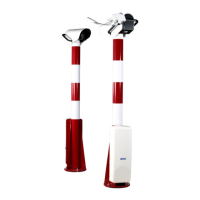Chapter 5 ________________________________________________________________ Operation
VAISALA ______________________________________________________________________ 191
Example:
Assuming that only sequence (A) (300 s) and sequence (D) (600 s) are
valid sequences, the data of sequence (A) will be reported for 300 s (five
minutes). After that the of sequence (D) will be reported for 600 s (ten
minutes).
After a total time of 15 minutes the reported data will be taken from
sequence (A) again. After a total time of 25 minutes the reported data
will be taken from sequence (D) and so on.
If simulation sequences are enabled for all messages, the value for MOR,
status, and background luminance are replaced by sequence data.
The LT31 sensor does not make any validity checks to the sequence data
contents.
As all messages do not have the capability to give all the defined data,
some message formats use only parts of the defined sequence data.
Message 1
Full data replacement.
Message 2
Full data replacement.
Message 4
Full data replacement with the following exception: visibility status is
replaced by the first character of the overall status. Other characters of
the overall status are omitted.
Message 7 (MITRAS)
Visibility and background luminance data are replaced. The status is
replaced by the first six characters of the overall status. Other characters
of the overall status are omitted.
Message 8 (SKOPO 2)
Visibility and background luminance data are replaced. The
transmittance is calculated based on visibility data and configured
baseline length.
The value for ln(ε
t
) is calculated based on the background luminance
data.

